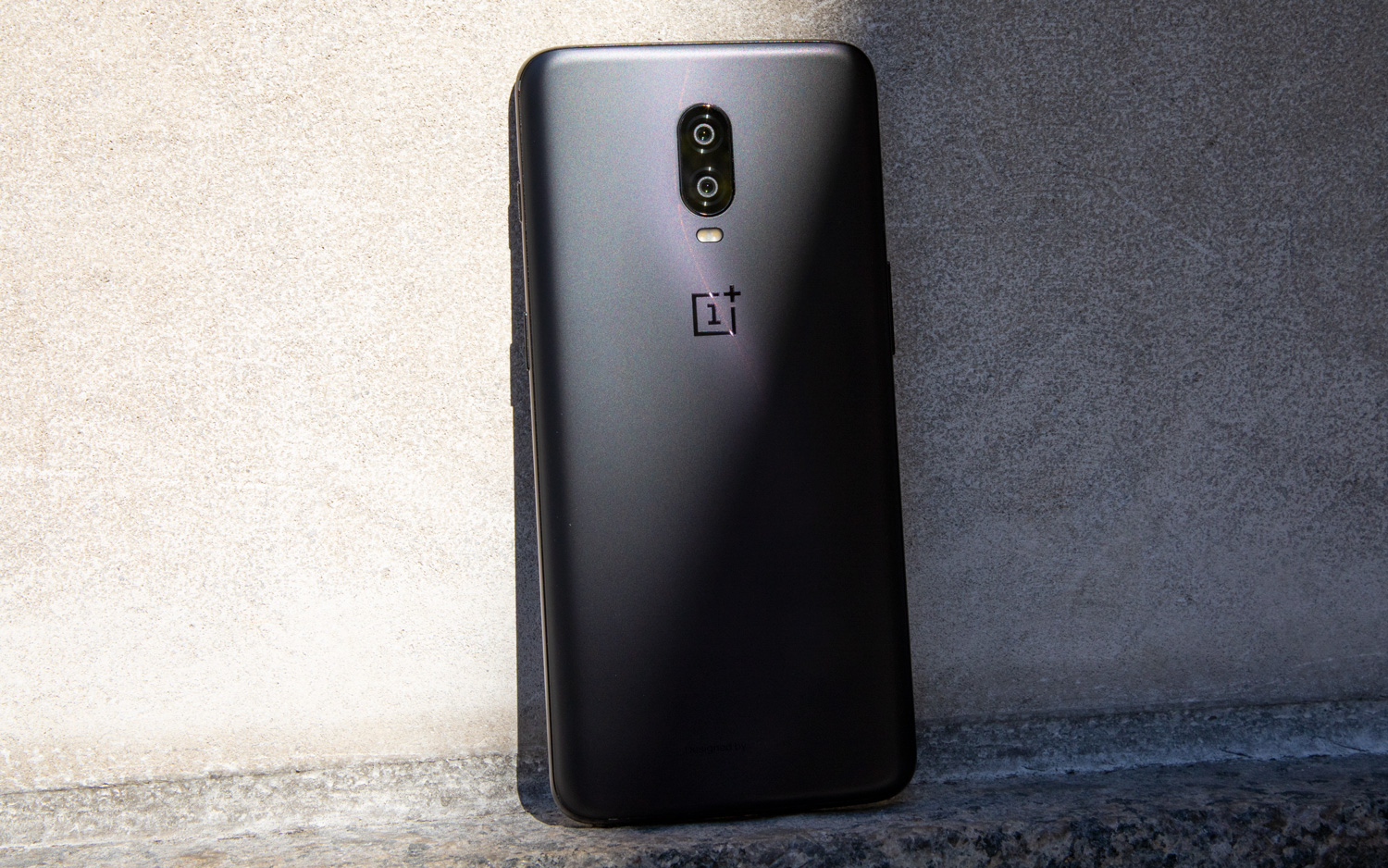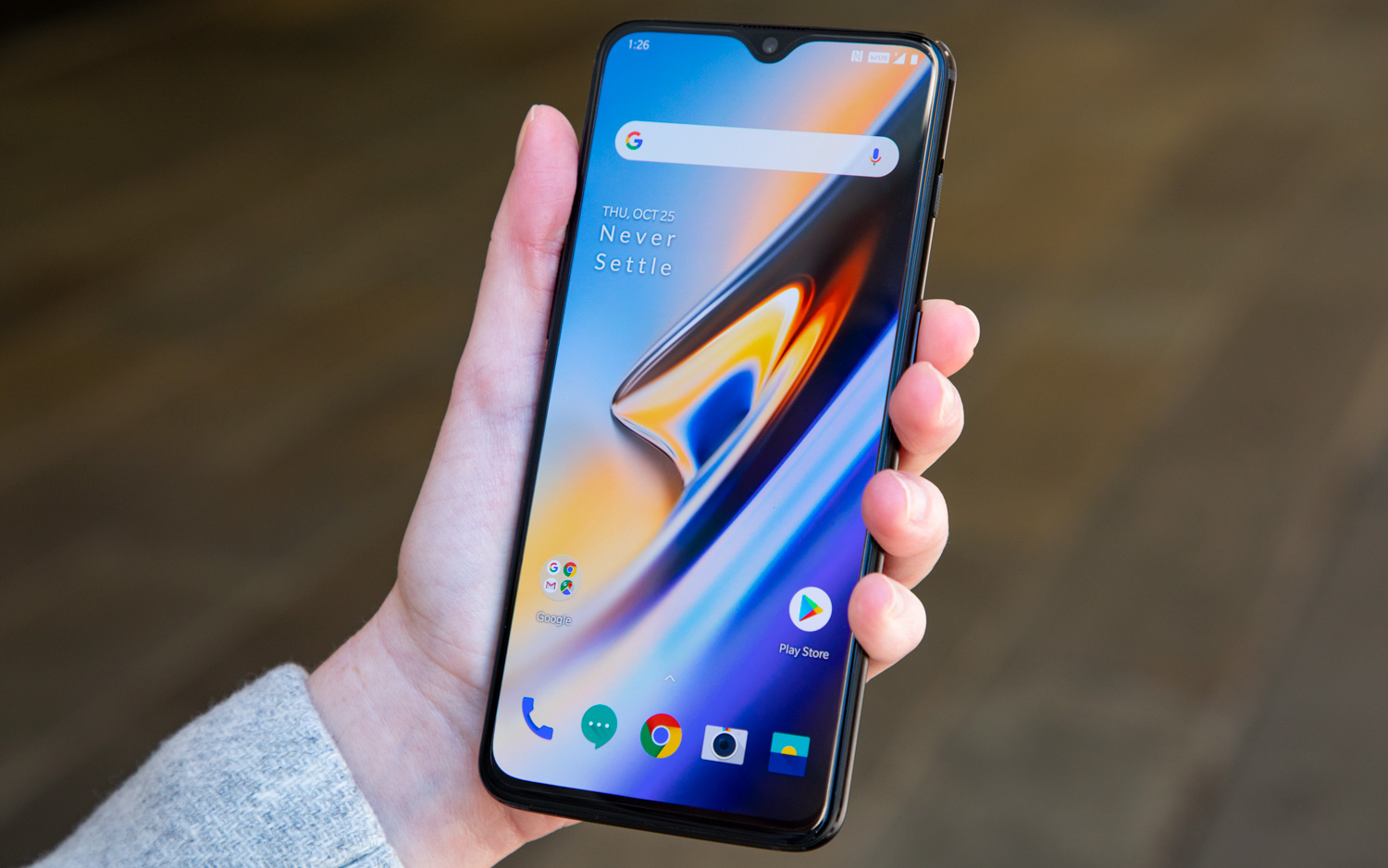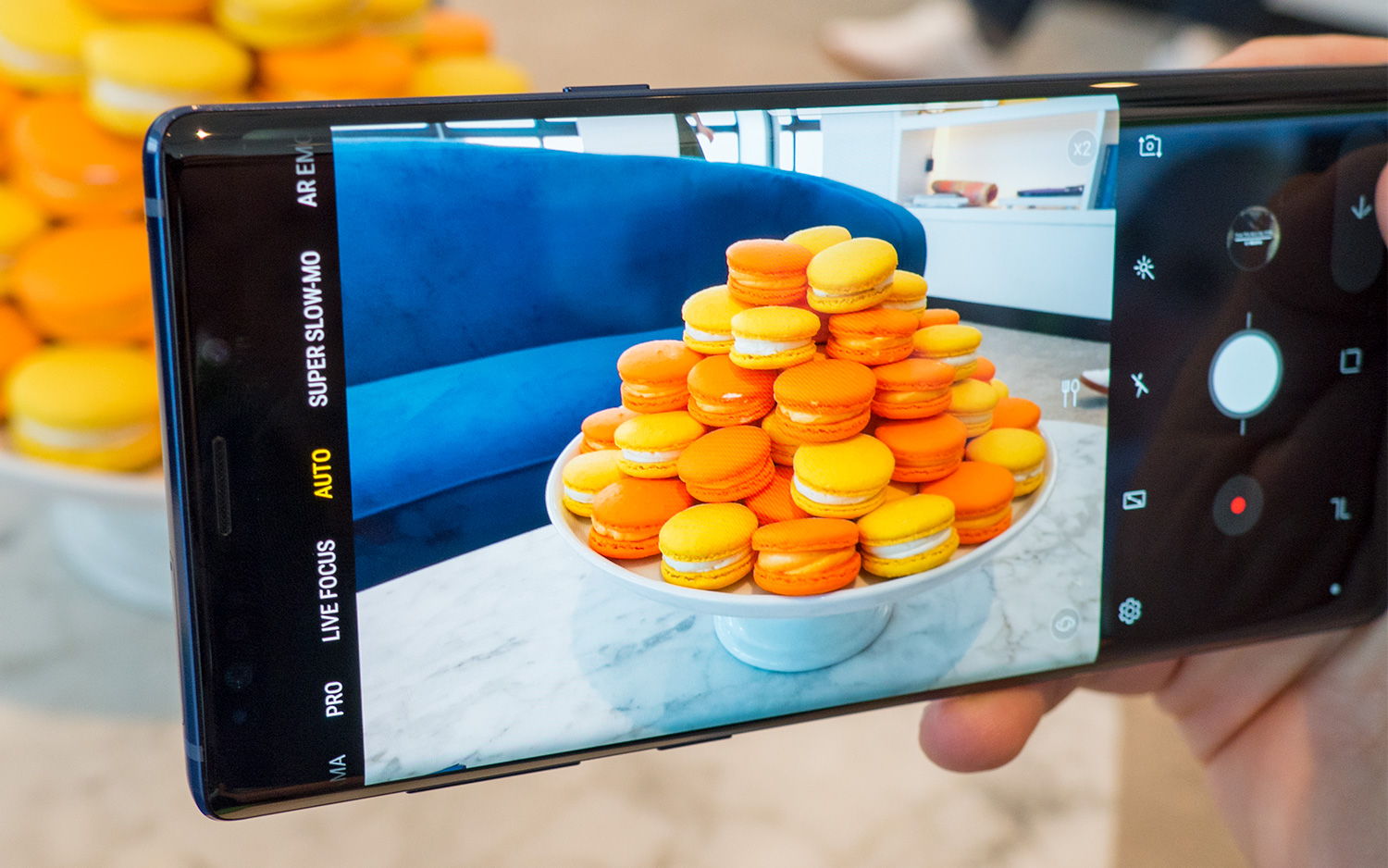OnePlus 6T vs. Galaxy Note 9: Is Samsung's Flagship $450 Better?
The OnePlus 6T's combination of flagship features and affordable price take on Samsung's ultra-premium Note 9.
OnePlus has staked out a position for itself and its feature-rich, affordably priced smartphones as "flagship killers." With the OnePlus 6T now available, could Samsung's Galaxy Note 9 be another notch in the upstart phone maker's belt?

At $549, the OnePlus 6T is much cheaper than the $999 Note 9.It's got the same processor and screen size as the Note 9, and it promises camera improvements that could close the gap with the best phone that Samsung has to offer.
But the Note 9 is formidable in its own right, offering an improved S Pen with remote- control capability, a huge battery and AI-powered cameras. Here's a closer look at how the OnePlus 6T measures up to the Galaxy Note 9 now that we've had a chance to put both phones through their paces.
OnePlus 6T vs. Galaxy Note 9: The Specs
| Row 0 - Cell 0 | OnePlus 6T | Galaxy Note 9 |
| Starting Price | $549 | $999 |
| Screen (Resolution) | 6.4 inches (2340 x 1080) | 6.4 inches (2960 x 1440) |
| CPU | Snapdragon 845 | Snapdragon 845 |
| RAM | 6GB, 8GB | 6GB, 8GB |
| Storage | 128GB, 256GB | 128GB, 512GB |
| MicroSD | No | Yes |
| Rear Camera | 16-MP (f/1.7), 20-MP (f/1.7) | Dual 12-MP (f/1.5-f/2.4) |
| Front Camera | 16-MP (f/2.0) | 8-MP (f/1.7) |
| Battery Size | 3,700 mAh | 4,000 mAh |
| Battery Life (Hrs:Mins) | 10:23 | 11:26 |
| Wireless Charging | No | Yes |
| Water Resistance | Splash resistant | IP68 |
| Size | 6.2 x 2.9 x 0.32 inches | 6.3 x 3 x 0.34 inches |
| Weight | 6.5 ounces | 7.1 ounces |
Design
Samsung has stuck with the same look for its flagships for two years running now, but why mess with something that works? The Note 9 puts the Infinity Display front and center in its design, giving this phablet a look that's every bit as distinctive as Apple's handsets. The biggest change to the look of the Note 9 addressed one of the biggest problems with the Note 8, as Samsung moved the rear fingerprint sensor to beneath the rear-camera setup from its awkward position right next to the lenses.

Similarly, the OnePlus 6T retains the glass design introduced with the OnePlus 6 earlier this year. The biggest change is one that's not likely to be well-received by traditionalists: OnePlus dropped the headphone jack from the 6T, a move that the phone maker concedes goes against the feedback it's gotten from customers. The Note 9 still has a headphone jack.
The new OnePlus phone can boast one big difference from other phones sold in the U.S. — it's got a fingerprint sensor embedded underneath the display. (Other phones had this feature first, but they're not available in the U.S.) The 6T's fingerprint reader is very fast, and an excellent use of the technology.
The OnePlus 6T is more compact than the Note 9, but only by fractions of inches. At 6.52 ounces, it's also lighter than the 7.1-ounce Samsung phone.

Samsung isn't exactly known for taking a chance with colors, but the phone maker has loosened up a bit with the Note 9. The phone debuted with less-conventional Lavender Purple and Ocean Blue options, subsequently adding Cloud Silver and Midnight Black to the mix. That's more options than you'll get with the OnePlus 6T, which just added a new purple model to join its two different shades of black.
MORE: OnePlus 6T Review: Pure Magic, Perfect Price
The Note 9 enjoys one other design edge over the OnePlus 6T. Thanks to an IP68 water resistance rating, the Note 9 can go for a swim in up to 5 feet of water for 30 minutes. OnePlus only says the 6T can resist splashes of water.
Winner: Note 9
Display
Both phones sport a 6.4-inch AMOLED screen, though the two panels take on different appearances. While the Note 9 offers an edge-to-edge Infinity Display with only a hint of a bezel at the top and bottom of the phone, the OnePlus 6T features a notch — albeit a more minimized teardrop-style notch than the iPhone X-like one that descended into the OnePlus 6's screen. At 2960 x 1440, the Note 9's resolution is also noticeably sharper than the 2340 x 1080 panel on the 6T.

Measuring brightness with a light meter, the Note 9's 604-nit result outshone the 405 nits we recorded from the 6T. Side-by-side indoors, we didn't notice much of a gap, but the Note 9's brighter screen makes a difference outside.

The phones' displays are equally colorful, with the Note 9 reproducing 224 percent of the sRGB color spectrum to the 6T's 222.6 percent. Those colors are just about as accurate, too, with nearly identical Delta-E ratings — 0.34 for the Note 9 and 0.36 for the 6T. (Numbers closer to 0 are better.)
MORE: Galaxy Note 9 vs. Pixel 3 XL: Which Big-Screen Phone Wins?
Watching the Detective Pikachu trailer on both phones in their default display modes, the OnePlus 6T's screen looked a bit more washed out and cooler. It definitely wasn't as sharp as the Note 9's panel, which is not surprising, given the differences in resolution. The Note 9 also has better viewing angles, retaining brightness better as we adjusted the angle of the phone in our hand.
Winner: Note 9
Camera
If there's one area where OnePlus' phones have fallen short of the "as good or better than any flagship" mantra, it's with the cameras. Cameras on OnePlus phones are typically good, though they have a hard time keeping up with Samsung's more expensive flagships.

The Note 9 sets a pretty high bar to beat. While the phone's twin 12-megapixel rear lenses aren't that different from the Galaxy S9+ (right down to the ability to switch the aperture from f/1.5 to f/2.4 as lighting conditions demand), Samsung beefed up the artificial intelligence on the Note 9 to recognize scene and optimize camera settings to produce the best shot.

The OnePlus 6T also puts the emphasis on software improvements rather than changing its 16- and 20-megapixel rear shooters. OnePlus added a Night Mode that lengthens the exposure time for more detailed shots when it's dark. Portrait mode also saw some improvements.
But are those changes enough? Certainly, the OnePlus 6T does a better job than previous OnePlus phones when the lights are low. But as we can see in this dimly lit shot featuring a stuffed bird, a candle and a pine cone, the Note 9 still reigns as the low-light king.
MORE: iPhone XS vs. Galaxy Note 9: Why Apple's Camera Wins
The individual objects look distinct in the Note 9's photo, and you can make out specific colors, even in the low light. The flickering candle flame looks blurred in the OnePlus 6T's shot, and there's a visible lighting artifact on the pine cone. The color's off on that couch cushion in the background, too.
Moving outdoors to a snowy scene didn't change matters any. The OnePlus 6T's shot looks good, with the trees in the background providing fine contrast, and the colors accurately reflect a wintry day. But the Note 9's version is sharper: It's easier to read all of the text on the sign that marks Washington's crossing of the Delaware, and the falling snowflakes stand out a little bit more.
OnePlus may have improved the portrait mode on the 6T, but it's not enough to overcome what the Note 9 can do with blurred backgrounds. At first glance, the images look fairly similar, but there's a little too much blur in the background of the 6T's shot, particularly around my colleague Adam's beard and shirt collar. The 6T's shot also has more of a zoomed-out perspective, which I don't particularly mind, but some of my colleagues didn't care for.
It's not a clean sweep for the Note 9's camera, though. The 16-MP front camera on the OnePlus 6T captured a better self-portrait of Adam. The colors are a little too warm in the selfie shot by the Note 9's 8-MP front shooter, and the right side of Adam's face has an unnatural shine. Things are much more balanced in the 6T's shot.
Winner: Note 9
Performance
You'd expect similar performance from the Note 9 and the OnePlus 6T since both phones feature the same Snapdragon 845 chipset you'll find in most leading Android handsets. And that's exactly what we got when we put both phones through a series of benchmark tests.

On Geekbench 4, which measures overall performance, the OnePlus 6T posted a score of 8,972. That just edged out the Note 9's 8,876 result, but that OnePlus win comes with a caveat. We tested the base model Note 9, which comes with 6GB of RAM. Our OnePlus 6T review unit featured 8GB of RAM. If we tested the base 6T model, which has the same RAM as the Note 9, it's possible that Samsung's phone would have turned in the better result; then again, that OnePlus 6T model costs even less than the $579 version we reviewed.
The OnePlus 6T also beat the Note 9 when we ran 3DMark's Slingshot Extreme 3.1 benchmark. The 6T recorded a score of 5,183, well ahead of the Note 9's 4,639 result.

Regarding special performance features, the Note 9 boasts a water/carbon-fiber cooling system designed to keep your phone humming along without throttling, particularly if you play a lot of processor-intensive games. We didn't notice a huge difference when testing the Note 9's water-cooling capabilities.
Meanwhile, OnePlus updated its OxygenOS with a new SmartBoost feature that clears background apps you use less often, improving launch speeds — and we definitely noticed this when testing the 6T.
Essentially, the OnePlus 6T enjoys a marginal edge over the Note 9 when it comes to performance. But that gap grows even bigger when you consider how much less you've paid for OnePlus' phone.
Winner: OnePlus 6T
Software and Special Features
Releasing the Note 9 in August helped Samsung beat other fall flagship releases to retail shelves. But it also means that the Note 9 ships with Android Oreo at a time when other phones — including the OnePlus 6T — are shipping with Android 9 Pie. What's more, OnePlus' Oxygen OS, which is built on top of the latest version of Android, offers a cleaner, more sophisticated experience than the TouchWiz user interface Samsung slaps on its Android phones. (Samsung seems to have acknowledged this with its preview of OneUI, the Android 9-based interface coming to the Note 9 and other phones next year.)
It would be a mistake, though, to dismiss the Note 9 just because its operating system is a little bit older. Samsung's phone offers several compelling special features, highlighted by the S Pen. The version of the stylus that accompanies the Note 9 adds Bluetooth connectivity, allowing you to use the S Pen as a remote control. Out of the box, that means the S Pen can be a remote shutter for when you want to snap a photo with the phone's camera, or you can use it to control a presentation or music playback when your Note 9's just out of reach. Samsung just released developer tools this month to allow software makers to build S Pen support into their own apps, so the stylus should get only more powerful over time.

The Note 9 also improves upon the DeX features Samsung has built into prior flagships that turned those phones into mini PCs when plugged into a monitor. Previously, that required a separate dock, but the Note 9 just needs an adapter and HDMI cable, making it easier to convert your phone into an ultra-portable PC, if that's how you roll.
We're less impressed by Bixby, Samsung's built-in digital assistant. Bixby remains a work in progress, even as Samsung fine-tunes it to let you make restaurant reservations or book Uber rides. Those features were hit-and-miss in our testing.

Because the OnePlus 6T's OS is built on the latest version of Android, you can enjoy Pie-specific features like gesture-based navigation and adaptive battery support. Google Lens, the AI-powered object recognition feature is built into the 6T's camera, while other features from the 6T's predecessor, such as Face Unlock and Gaming Mode, return in this iteration of OnePlus' flagship device. These are all nice features, but they really don't offer the expansive capabilities you'll get with the Note 9's S Pen, one of the top add-ons you'll find with any flagship phone.
Winner: Note 9
Battery Life
The Note 9 boasts a bigger battery than the OnePlus 6T — 4,000 mAh versus 3,700 mAh. And bigger turns out to be better, at least when it comes to results on our Tom's Guide battery test.

We set up both fully charged phones to continuously surf the web over T-Mobile's LTE network until they ran out of juice. The OnePlus 6T lasted for 10 hours and 23 minutes — a little bit more than a half-hour longer than the average smartphone. But the Note 9 turned in an even better time. It lasted 11 hours and 26 minutes, beating the 6T's time by more than an hour. (We got that result by turning off the Note 9's adaptive display feature. With adaptive display enabled, the Note 9 lasted 11:16, which still topped the OnePlus 6T.)

The Note 9 enjoys another power advantage over the 6T, as you can charge Samsung's phone wirelessly. You can't do that with the OnePlus 6T, but at least that phone still supports OnePlus' Dash Charge feature, which gets the 6T to a 60 percent charge after just 30 minutes.
Winner: Note 9
Price and Availability
There's no getting around the vast gulf in price between these two phones. The Galaxy Note 9 is the poster child for the skyrocketing price of flagship phones, with a starting price of $999 for a model with 6GB of memory and 128GB of storage. The base model OnePlus 6T has those same memory and storage specs, but costs $450 less.
Even if you were to max out memory and storage on the OnePlus 6T — opting for 8GB of RAM and 256GB of onboard storage — you'd still only pay $629. That's a $370 discount off the Note 9's starting price.
The Note 9 enjoys an edge when it comes to offering more storage, with its 512GB model. Of course, you'll pay for the privilege, with that phone setting you back $1,249.
You'll find the Note 9 available from every major U.S. carrier, usually an edge that flagships from Samsung enjoy over their unlocked rivals. But OnePlus negates some of that advantage with the 6T: It's the first OnePlus phone to be available through a carrier (T-Mobile in this case). In addition, the 6T works on Verizon's CDMA-based network in addition to the GSM networks of T-Mobile and AT&T.
Winner: OnePlus 6T
Bottom Line
The OnePlus 6T has a lot of things going for it, chiefly that it delivers top-of-the-line features at a price that's far lower than what you'd pony up for most top-of-the-line phones. But as attractive as that price is, OnePlus'’s phone is bested by the Note 9 in too many categories — not by a lot, most of the time, but enough to make the Note 9 the better option if you want the top big-screen phone.
| Row 0 - Cell 0 | OnePlus 6T | Galaxy Note 9 |
| Design (10) | 8 | 9 |
| Display (20) | 16 | 18 |
| Camera (20) | 16 | 19 |
| Performance (20) | 17 | 16 |
| Software/Special Features (10) | 7 | 9 |
| Battery (10) | 7 | 9 |
| Price/Availability (10) | 10 | 7 |
| Overall (100) | 81 | 87 |
Credit: Tom's Guide
Sign up to get the BEST of Tom's Guide direct to your inbox.
Get instant access to breaking news, the hottest reviews, great deals and helpful tips.
Philip Michaels is a Managing Editor at Tom's Guide. He's been covering personal technology since 1999 and was in the building when Steve Jobs showed off the iPhone for the first time. He's been evaluating smartphones since that first iPhone debuted in 2007, and he's been following phone carriers and smartphone plans since 2015. He has strong opinions about Apple, the Oakland Athletics, old movies and proper butchery techniques. Follow him at @PhilipMichaels.
-
johnshaft64 The Samsung Galaxy Note 9 does have wireless charging. Not as fast as One Plus 6T but it does. Correct the specs.Reply -
PhilipMichaels Reply21493543 said:The Samsung Galaxy Note 9 does have wireless charging. Not as fast as One Plus 6T but it does. Correct the specs.
You're right -- that row in the specs table got flipped around, and has been corrected. -
l3anyan i think the oneplus low light pictures and the portraits are a bit more true to life. the samsung looks like it applies a yellowish filter to pop the contrast more to me. the other pictures the samsung is simply darker. but seriously? $1k for a phone?!? i wish someone would make a dumbphone that had the ability to play podcasts.Reply -
lee.hounshell Just now I am running Linux on my Note 9 using the new Linux on Dex beta. My Note 9 is now a real computer with most of the development tools I need. No other phone can do that. Linux on Dex includes IntelliJ Idea. For me, the Linux option for Note 9 makes it the best phone.Reply

